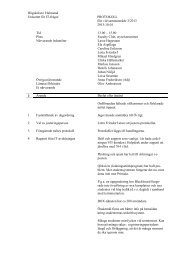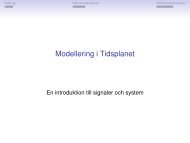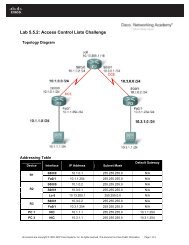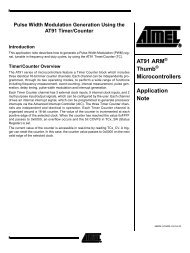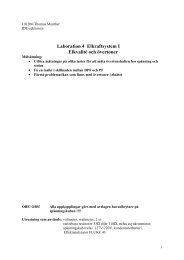ANNUAL REPORT 2012
ANNUAL REPORT 2012
ANNUAL REPORT 2012
You also want an ePaper? Increase the reach of your titles
YUMPU automatically turns print PDFs into web optimized ePapers that Google loves.
WisCon - Wireless sensor concept node<br />
WiSCoN – WIRELESS SENSOR CONCEPT NODE<br />
P. Enoksson 1 , B. Fliesberg 2 , E. Johansson 3 , M. Jonsson 4 , K. Kunert 4 , and M. Öhman 3<br />
1. Chalmers University of Technology, Gothenburg, Sweden<br />
2. Volvo 3P, Gothenburg, Sweden<br />
3. Volvo Technology Corporation, Gothenburg, Sweden<br />
4. Centre for Research on Embedded Systems (CERES), Halmstad University, Halmstad, Sweden<br />
The objective of the project is to explore and show the concrete benefits and potential of self-sustaining wireless sensors and<br />
to understand their limitations. The scope of the project includes not only wireless communication, but also aspects related to<br />
energy supply and storage. The intention is to build a wireless-sensor concept node that can be used to realistically assess the<br />
feasibility of self-sustaining wireless sensors from an industrialization viewpoint.<br />
1. Background and Motivation<br />
In today’s advanced and complex vehicles systems, sensors<br />
are key components, acting as sources of much of the data<br />
that is required input into a large number of complex invehicle<br />
control functions. Typically, the sensors’ power<br />
supply, as well as the data exchange, is realized with<br />
standard wiring. A reduction or elimination of sensor<br />
wiring will allow for a reduction of material cost, product<br />
weight (leading to better fuel economy), and issues with the<br />
wiring harness quality. It will also enable new concepts that<br />
are infeasible today due to limitations set by the wiring<br />
harness (routing and packaging issues, placement of<br />
moving parts, etc.).<br />
The purpose of this project is to build a knowledge base<br />
covering the technology behind self-sustaining wireless<br />
sensors in vehicles. The goal is to realistically assess the<br />
feasibility of wireless sensors from an industrialization<br />
viewpoint.<br />
We aim at developing a wireless-sensor concept node for<br />
studying and evaluating various concepts and technologies<br />
needed for wireless sensors for automotive applications,<br />
including energy supply, communication technologies, and<br />
power management. The overall goal is to explore and<br />
show the concrete benefits and potential of self-sustaining<br />
wireless sensors and also to understand its limitations.<br />
Some of the prospective benefits of wireless sensors in<br />
automotive applications include:<br />
Reduction of product cost by elimination of wiring<br />
harness and connectors<br />
Increased quality by removing sources of failures<br />
related to wiring and connectors<br />
Reduction of manufacturing and aftermarket costs by<br />
reducing the installation and replacement time for<br />
sensors<br />
Reduction of wiring harness variants (→ simpler<br />
variant handling → lower development and product<br />
cost)<br />
Possibility to place sensors where it is infeasible to<br />
have wired sensors (such as moving and sealed parts)<br />
2. Approach<br />
In order to achieve the vision of self-sustaining wireless<br />
sensors, it is necessary to achieve a good level of maturity<br />
in a number of technologies, such as energy harvesting,<br />
local energy storage, wireless energy distribution, lowpower<br />
sensor technologies, and short-range wireless<br />
communication.<br />
Local energy storage<br />
Energy storage can be dimensioned to carry energy for<br />
short time intervals (as a container for locally generated<br />
energy), or for long time intervals (service period or<br />
lifetime of a vehicle). Possible short-time storage<br />
technologies include, e.g., rechargeable batteries (NiMh,<br />
LiIon, etc.) or small supercaps. For long-time storage nonrechargeable<br />
battery technologies are a possibility.<br />
Energy harvesting devices<br />
MEMS (Microelectromechanical systems) based energy<br />
harvesting devices can generate energy in the µW range<br />
from vibrations. In most cases this is too low for powering<br />
sensors, but combined with efficient energy storage, a<br />
complete system can be built.<br />
Low power sensors<br />
Ultra-low power sensors available on the market together<br />
with proper energy management make it possible to lower<br />
the energy consumption of a sensor node so it can be<br />
powered by an energy scavenger.<br />
Short range wireless digital communication<br />
Communication between the sensor nodes need to be<br />
energy efficient. Quality of service issues need to be<br />
addressed, and frequency and modulation must be chosen<br />
correctly in order to increase the probability of signals<br />
reaching the receivers in a space full of metallic structures.<br />
Partners and Status<br />
Academic partner: Chalmers University of Technology<br />
Industrial partner: Volvo Technology Corporation<br />
Project funding: Funded by VINNOVA through the FFI –<br />
Strategic Vehicle Research and Innovation program<br />
(Vehicle Development collaboration program)<br />
Project volume: 5.24 MSEK (HH share: 0.35 MSEK)<br />
Duration: January 1, 2011 – December 31, 2013.<br />
Project leader: Mikaela Öhman, Volvo Technology<br />
Corporation<br />
Participating researchers at CERES: Dr Kristina Kunert,<br />
Prof. Magnus Jonsson<br />
CERES Annual Report <strong>2012</strong><br />
31



